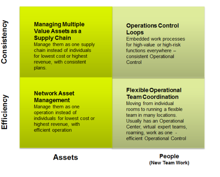I have discussed at length the transition of our
workforce and that it is not just going to a new generation ( 42% of the workforce
by 2020) but it is the dynamic culture of this workforce ( tenure ship less
that 2.4 years in the role by 2020) that poses one of the biggest challenges to
the industrial operational/ automation workplace.
At a dinner in Florida I was sitting next to a gentlemen
in charge of "change management" at a counties power facilities major
power stations. A major part of the focus is on training, and knowledge
transfer. The conversation initially focused on the challenge of "baby
boomer" retiring over the next 5 to 8 years and the knowledge, experience
"walking out" the door. It was interesting to understand how stable
his automation and operational work
force has been for the last 20 to 30 years. They are a premier employer in the
area, and most of the current work force has come from trainee and full careers
there, many were there when the power plants were commissioned, growing up with
the plants.
Reminding me of a saying by a colleague "that when
he joined the workforce on plants, the average age was his age eg 20, now that
he is in his late 50s the average age of the workforce on a plant he visits is
still his age ( late 50s)." As we had dinner this, saying was ringing in
my head as the stories from the power plants came out.
As the dinner progressed the other challengers came out that
they were building new gas powered plants, shutting down some of the older
power units, and the new workforce was aged less that 35 years old, (most
younger) and little to no experience. The shorter tenure ship in a role he had
not seen yet, but when discussing he had noticed a trend to rotating roles, and
want to progress, new challenges, and with the new gas plants with new
technology and learning he saw the challenge not far off.
So he has embarked on a significant Operator Training
Simulation Program. Work on three fronts:
1/ power unit operations
2/ power unit maintenance and start up, shut down
3/ environmental / energy management
These are 3 different communities of the workforce, the
third being a specialized one which is becoming critical due to government
regulations and the heavy fines, so understanding how to seal with different
situations including weather and load is key.
The first step is to really structure the training
knowledge capture from the “baby boomers" capturing their experience in
operations reacting to situations, and performing maintenance. Action and
knowledge they take for granted now caught in the simulation models and built
in as training scenarios that can play over and over again.
His learnings are also supported in the diagram below:
He also talked about not just simulations, but his
learning has been the other training tools, measurements within the OTS tools
that he did not initially appreciate (or use until recently) that allow the
training to evolve, and improve as well develop the team.
The big walk away I had from this dinner discussion was
that he could not see how they would go through this workforce transition, and
plant transition, and maintain the current operational levels in efficiency and
safety without automated, simulation tools.
His whole story was micro example of what I am seeing
across the world, but so many are not acting, he had been implementing a
"change management" plan based around simulation learning for the
last 4 years, and he was still evolving, but seeing significant returns.
On the new plants, they will have simulation as part of
the plant design and operator training simulation from the outset.
Yet a week later across the other side of the world in
mining, (where an even more dynamic workforce transition is happening, with combination significant workforce
rotation and retirement) the shift to simulated online training is seen as
a "nice to have".
Key as we look forward there are 3 big areas that need to
align, Operational performance Asset utilization / efficiency Operational
workforce effectiveness. They are all equal and dependent on each other, and the leading companies will be
the ones that master the balance across the three as the dynamics in all three
increases.
Next week I will expand on knowledge dissemination,
learning transformation that is and will have to happen in the industrial
space.







